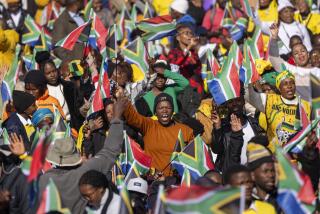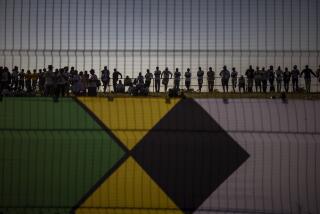Why S. African Black Fury Turns on Itself
- Share via
SOWETO, South Africa — The year is ending with black South Africa licking its wounds. The ordinary township resident was at the mercy of government forces on the one hand and township militants on the other.
Birdshot, rubber bullets, tear gas, truncheons and live bullets are not selective about their victims. They hit all in their path, activist or not. Similarly, black fury, unable to expend itself on the “enemy,” burned itself out in the townships. Members of the community suffered more than the system being fought. To understand the real effect of this, it is necessary to examine some specifics.
This year more than 900 people have died in the unrest, more than 90% of them black. More than 8,000 people have been detained since the state of emergency was imposed July 20. Of this 8,000, more than 1,000 are still imprisoned; the rest have been released after spending varying periods in jail. Some areas have had tear-gas fumes hang over them like angry clouds after police used the gas to disperse crowds. Rubber bullets, birdshot and police boot kicks took their toll on township youths. Attacks by police armed with truncheons were just as frequent. Curfews imposed in many townships also affected entire communities, curtailing sharply the already limited social outlets available.
Within the townships themselves militants had their own sets of laws. The community had to obey or its residents ran the risk of being burned to death. Political thugs, who always appear during periods of unrest, took over demonstrations and exploited them for their own ends. People were robbed, houses burned and motorists frequently subjected to rock throwings. And all this harassment was committed in the name of the liberation struggle. Gangs of youths raided homes, and residents watched helplessly as their property was smashed and money and valuables were stolen. On one or two occasions horrified parents were forced to watch while their daughters were raped.
When the consumer boycott was announced in Transvaal towns this fall, the criminal harassment escalated. People were assaulted for buying in the towns while at the same time delivery vehicles entering the townships were attacked and set alight. The reasoning behind this was inexplicable. Was the community expected to starve?
There were also vicious personal attacks. Women with “permed” hair were accosted in the street and forcibly sheared because they were wearing Western hairstyles. Women also were subjected to body searches to make sure that they were not bringing in goods bought in town.
Youth leaders contended that thugs took over control of the political struggle in many areas, using it as an excuse to harass the community. But there is no denying that many youths, some of them boycotting students, joined the unsavory elements in terrorizing entire communities. Why did students, of all people, join this kind of hooliganism?
After months of class boycotts the students had become bored. They then either initiated their own revolutionary program or were assisted by the thugs in forcing residents to support half-baked campaigns. The adults, as with most other middle-aged communities, are slow to join radical action. Black adults in South Africa generally try hard to avoid confrontation with the government.
On the other hand, the young people, always ready to take the bull by the horns, took it upon themselves to challenge the status quo. Thus a clash between parents and children was inevitable when township youths coerced their parents into participating in demonstrations. Most black leaders had been arrested, while others had gone underground. With the head missing, the body flailed and was easily manipulated by opportunistic leaders and government ploys.
With the “enemy” miles away and some townships sometimes surrounded by army camps (there are three around Soweto), the government succeeded in restricting black fury to black neighborhoods--thus the people’s anger expended itself in their own communities. It was dismaying to find that toward the end of the year township youths, hitherto respected as the champions of black liberation, faced the danger of being alienated from the community that they wanted to free from oppression.
The government, always anxious to exploit any divisions in the black community, was ready to give support to groups fighting activist youths. Thus one of the challenges that face mass support organizations such as the United Democratic Front and the Azanian Peoples Organization in the new year is to wipe these political thugs off the face of the struggle. Already the Soweto Youth Congress and the Release Mandela Committee have undertaken a cleanup campaign.
Black South Africa supports the liberation struggle and all liberation movements within as well as outside of the country, but it draws the line at political hooliganism.
More to Read
Sign up for Essential California
The most important California stories and recommendations in your inbox every morning.
You may occasionally receive promotional content from the Los Angeles Times.










